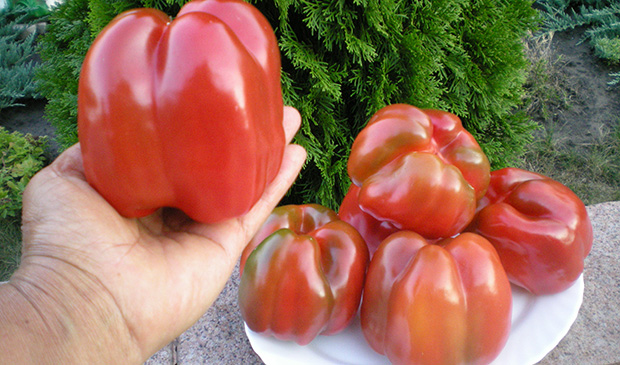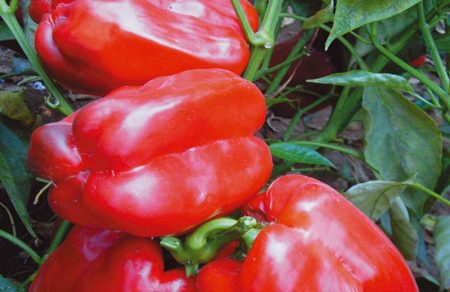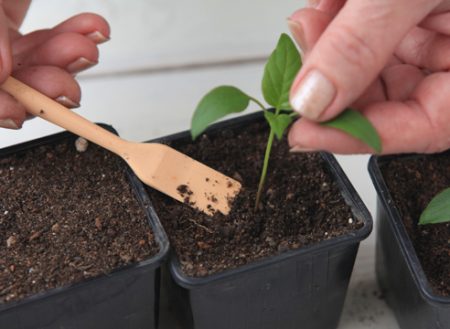 Despite the abundance of peppers of various types, sizes, colors on the modern market, gardeners want to grow their crop of this vegetable, environmentally friendly, without the addition of chemicals. It is widely used in cooking: it is consumed fresh, added to salads, soups, canned, frozen for the winter. And not in vain, because any pepper contains a large amount of beta carotene, pectin and vitamin C.
Despite the abundance of peppers of various types, sizes, colors on the modern market, gardeners want to grow their crop of this vegetable, environmentally friendly, without the addition of chemicals. It is widely used in cooking: it is consumed fresh, added to salads, soups, canned, frozen for the winter. And not in vain, because any pepper contains a large amount of beta carotene, pectin and vitamin C.
Content
Grade characteristics
Giant F1 pepper is an early ripening variety, from sowing seeds to the appearance of the first fruits takes up to 130 days or less. The bush is quite high, about a meter high with widely spread shoots. To avoid breaking branches under the weight of the fruit, they are usually tied.
Important! Not all plants reach this height, it all depends on the cultivation conditions.
The hybrid variety fully justifies its name, the fruits are large, fleshy, thick-walled (up to 13 mm), cubic in shape, weighing up to 300 g. Up to 8 kg of fruits are removed from one bush with proper care. Coloring can be red, yellow or orange.

The giant with red fruits contains a lot of beta carotene, in a quantitative ratio even more than in the record holder - carrots. Peppers with yellow and orange fruits do not have it, they are bred for use by people allergic to vegetables and red fruits. This deficiency is compensated by a high content of pectin and vitamin C, and orange fruits are also rich in potassium. The taste of the fruits of all colors are slightly different.
Growing Features
Sowing for growing in a greenhouse is carried out in late January - early February, for open ground - in March. For seedlings, it is better to take prepared soil for peppers and tomatoes in specialized stores. Seeding of seeds is not deeper than 3-4 cm, the container with seeds is covered with a film or glass and placed in a warm bright place until the first shoots appear.
Attention! Productivity and taste of fruits directly depend on the seed material, so it must be purchased from reliable suppliers.
When the first two true leaves appear on the seedlings, they are dived into individual containers. Pepper is difficult to transplant, so for a while it can stop growth.

After the warm weather is established, the threat of return frosts has passed, grown seedlings are planted in the ground. Pepper plants do not deepen; they, unlike tomatoes, do not form lateral roots. When planting, you should adhere to the following scheme: 50 cm between adjacent plants, between rows 75-80 cm. Now the seedlings need timely watering, removing weeds, loosening. The best predecessors are garlic, cucumbers, radishes, onions.
Attention! Peppers love open sunny places and fertile light soils.
The Giant F1 variety is resistant to the diseases and pests characteristic of this crop. Since the bush is sprawling, an untimely garter and strong winds can lead to the fact that the shoots can break. In this case, the fruits break off, are placed in the shade and reach biological maturity.
Grade Advantages:
- High yield.
- The fruits are juicy, with fleshy walls.
- Excellent taste, sweet, without bitterness.
- Resistant to diseases and pests.
- Simple agricultural technology.
The disadvantages of the variety:
- Demanding on the soil.
- The likelihood of broken shoots, which reduces yield.
- The need to remove stepsons.
Application, storage conditions
Fruits of all colors are suitable, except for fresh consumption, for preserving, due to their  juiciness and high content of vitamin C. It is known that large peppers are often stuffed with a mixture of minced meat with rice. Suitable for freezing, as individual fruits, and as part of vegetable mixtures. It is often a vivid complement to second courses, appetizers, salads, and lecho.
juiciness and high content of vitamin C. It is known that large peppers are often stuffed with a mixture of minced meat with rice. Suitable for freezing, as individual fruits, and as part of vegetable mixtures. It is often a vivid complement to second courses, appetizers, salads, and lecho.
Easily tolerates transportation, stored in a cool room, to prolong freshness it is recommended to periodically spray the fruit. It has a good presentation, the fruits are bright, large, with a glossy sheen, often grown for sale.
Also find out characteristics of bell pepper.
Galina Sergeevna, 54 years old:
I have been growing peppers for several years, recently after planting in open ground seedlings began to be affected by various diseases. With seedlings, it has been worn since March, but no crop. I decided to try a hybrid variety of pepper Giant, they say that it is resistant to disease. This year, only a few seedlings were infected, which I immediately removed, from the rest I picked fruits - large, juicy, sweet.
Andrei Grigoryevich, 48 years old:
For cultivation in the country, we select only this variety of pepper, before that only took red, this year they tried yellow. They collected 15 kg from three bushes, planted a sample. My wife pickled with cucumbers, pepper was the first to leave - crispy, juicy. Next year we will plant more, we’ll also try orange. The care is simple, the main thing is to water on time and tie up the branches so that they do not break.




 Calorie pepper stuffed with meat and rice - BZHU per 100 grams
Calorie pepper stuffed with meat and rice - BZHU per 100 grams Gorky pepper - the best varieties for open ground
Gorky pepper - the best varieties for open ground Hot pepper seeds - the best varieties for open ground and reviews
Hot pepper seeds - the best varieties for open ground and reviews Capsicum tincture for hair - how to use and reviews
Capsicum tincture for hair - how to use and reviews